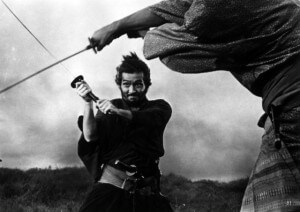Movie a Day Blog has long been fascinated by Japanese cinema. Its incredible sense of innovation within a very formalist structure and society is remarkable.
HARAKIRI (1962, Criterion Collection, Netflix DVD) offers testimony to this success with a precise, carefully measured tale of ritual suicide by disembowlment, overt class discrimination and a samurai willing to expose the social and political hierarchy for the fraud it was in 17th century Japan.
Directed by samurai and supernatural film master Masaki Kobayashi, HARAKIRI is distinctive for what it doesn’t do: there is barely any action in this two-hour-plus film. Most of the story is just that: stories told by one character or another, always in a seated position in front of a filled courtyard of shogun clan retainers, eager to see someone live up to the title’s promise.
Also called seppuku, harakiri is a form of suicide celebrated for its selflessness, and loyalty to a master who can no longer be served. Kobayashi cleverly sets his story in a time of peace in the early 1600s, when the ronin (or samurai) had no purpose in life since all individual and group combat was in abeyance.
Surprisingly, samurai started showing up at various clans’ headquarters engaged in a shakedown of sorts: pay them to go away, or end up with a bloody spectacle of disembowelment on your front lawn. It gave all the samurai a bad name, and no one with the intent to ritually do away with themselves was welcome.
Except for the samurai played by the charismatic Tatsuya Nakadai, a stage actor who had undeniable screen presence in several samurai pictures. His character, another retired ronin, has a number of different agendas, from revenge to being a kind of Japanese whistle-blower, willing to speak truth to power, and have the warrior skills to back it up.
The action is a long time coming in HARAKIRI; it doesn’t really unfold until the final half-hour of the movie, when its entire visual style changes in favor of tension, violence, fear and coolness under fire. What’s remarkable is how effectively Kobayashi and screenwriter Shinobu Hashimoto keep our attention in a movie that is almost all talk.
The film itself is a series of told stories, and the metaphor works: HARAKIRI is one fascinating story after another revealed as flashbacks or the same story from two points of view. The intensity of Nakadai’s performance, which is compelling every time the camera studies him, animates all the latent class tension that feeds the narrative of HARAKIRI.
My recent discovery of the tremendous power of Yasujiro Ozu’s cinema is now further enlightened by the fusion approach employed by Kobayashi. He seems to combine the formalism of Ozu’s static visual compositions with director Akira Kurosawa’s kinetic energy and moving shots.
The fight sequence in a storm-tossed meadow is powerful beyond words: it is the image that rules here. This is among the greatest sword duels in movie history, although it is reported that Nakadai was terrified since director Kobayashi insisted on using real, fully sharpened swords in the fight sequences. (The practice was finally outlawed in the Japanese film business by the 1970s, but made several non-sword master actors extremely nervous up until that point.)
HARAKIRI is a subtle movie in how it weaves a spell around the viewer, and pulls one into a world completely unfamiliar to those raised in the West. It is considered a masterpiece of the samurai genre, which is ironic given the general lack of samurai swordplay until the film’s finale.
The masterpiece designation works in several other areas also, and the film’s psychological acuity and exploration of guilt and sacrifice are ultimately more impressive than its expression of bushido, the samurai warrior spirit. HARAKIRI disembowels the very core of Japanese society, exposing something that deserved to be cut out.


Comments are closed